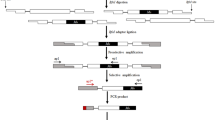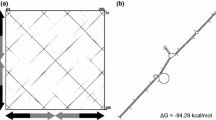Summary
In the progeny of an active Mutator plant, the number of Mu elements increases on self-pollination and maintains the average parental Mu content on outcrossing to a non-Mutator line; both patterns of transmission require an increase in the absolute number of Mu elements from one generation to the next. The same average copy number of Mu elements is transmitted through the male and female, but there is wide variation in the absolute copy number among the progeny. In inactive Mutator plants —defined both by the loss of somatic instability at a reporter gene (bronze2-mu1) and by modification of the HinfI sites in the terminal inverted repeat sequences of Mu elements —the absolute copy number of Mu elements is fixed in the parent. Thus, in outcrosses Mu element number is halved, and on self-pollination Mu copy number is constant. Reactivation of somatic mutability at cryptic bz2-mu1 alleles in inactive individuals by crossing to an active line seems not to involve an increase in Mu element copy number transmitted by the inactive individual. These and other results suggest that increases in Mu copy number occur late in plant development or in the gametophyte rather than after fertilization.
Similar content being viewed by others
References
Alleman M, Freeling M (1986) The Mu transposable elements of maize: evidence for transposition and copy number regulation during development. Genetics 112:107–119
Barker RF, Thompson DV, Talbot DR, Swanson J, Bennetzen JL (1984) Nucleotide sequence of the maize transposable element Mu1. Nucleic Acids Res 12:5955–5967
Bennetzen JL (1984) Transposable element Mu1 is found in multiple copies only in Robertson's mutator maize lines. J Mol Appl Genet 2:519–524
Bennetzen JL, Swanson J, Taylor WC, Freeling M (1984) DNA insertion in the first intron of maize Adh1 affects message levels: cloning of progenitor and mutant Adh1 alleles. Proc Natl Acad Sci USA 81:4125–4128
Chandler VL, Walbot V (1986) DNA modification of a maize transposable element correlates with loss of activity. Proc Natl Acad Sci USA 83:1767–1771
Chandler VL, Rivin CJ, Walbot V (1986) Stable non-Mutator lines of maize have elements homologous to the Mu1 transposable element. Genetics 114:1007–1021
Dennis ES, Gerlach WL, Pryor AJ, Bennetzen JL, Inglis A, Llewellyn D, Sachs MM, Ferl RJ, Peakcock WJ (1984) Molecular analysis of the Alcohol dehyrogenase (Adh1) gene of maize. Nucleic Acids Res 12:3983–4000
Fedoroff NV (1983) Controlling elements in maize. In: Shapiro J (ed) Mobile genetics elements. Academic Press, New York, pp 1–63
Feinberg AP, Vogelstein B (1983) A technique for radiolabeling DNA restriction endonuclease fragments to high specific activity. Anal Biochem 132:6–13
Freeling M (1984) Plant transposable elements and insertion sequences. Annu Rev Plant Physiol 35:277–298
Freeling M, Bennett DC (1985) Maize Adh1. Annu Rev Genet 19:297–323
Greenblatt IM (1984) A chromosome replication pattern deduced from pericarp phenotypes resulting from movements of the transposable element, Modulator, in maize. Genetics 108:471–485
Maniatis T, Fritsch EF, Sambrook J (1982) Molecular Cloning: a laboratory manual. Cold Spring Harbor Laboratory Press, New York
O'Reilly C, Shepherd NS, Pereira A, Schwarz-Sommer Z, Bertram I, Robertson DS, Peterson PA, Saedler H (1985) Molecular cloning of the al locus of Zea mays using the transposable elements En and Mu1. EMBO J 4:877–882
Rivin CJ, Cullis CA, Walbot V (1986) Evaluating quantitative variation in the genome of Zea mays. Genetics 113:1009–1019
Robertson DS (1978) Characterization of mutator system in maize. Mutat Res 51:21–28
Robertson DS (1985) A possible dose-dependent inactivation of mutator (Mu) in maize. Mol Gen Genet 191:86–90
Robertson DS (1985) Differential activity of the maize mutator Mu at different loci and in different cell lineages. Mol Gen Genet 200:9–13
Robertson DS, Stinard PS, Wheeler JG, Morris DW (1985) Genetic and molecular studies on germinal and somatic instability in Mutator-induced aleurone mutants of maize. In: Freeling M (ed) Plant Genetics. UCLA Symposium on Molecular and Cellular Biology, Vol 35. Alan R. Liss, New York, pp 317–331
Taylor LP, Walbot V (1987) Isolation and characterization of a 1.7 kb transposable element from a Mutator line of maize. Genetics, in press
Taylor LP, Chandler V, Walbot V (1986) Insertion of 1.4 kb and 1.7 kb Mu elements into the Bronze1 gene of Zea mays. Maydica 31:31–45
Walbot V (1986) Inheritance of Mutator activity in Zea mays as assayed by somatic instability of the bz2-mu1 allele. Genetics 114:1293–1312
Walbot V, Briggs CP, Chandler V (1986) Properties of mutable alleles recovered from mutator stocks of Zea mays L. In: Gustafson JP (ed) Genetics, Development, and Evolution. Plenum, New York, pp 115–142
Author information
Authors and Affiliations
Additional information
Communicated by H. Saedler
Rights and permissions
About this article
Cite this article
Walbot, V., Warren, C. Regulation of Mu element copy number in maize lines with an active or inactive Mutator transposable element system. Mol Gen Genet 211, 27–34 (1988). https://doi.org/10.1007/BF00338389
Received:
Issue Date:
DOI: https://doi.org/10.1007/BF00338389




